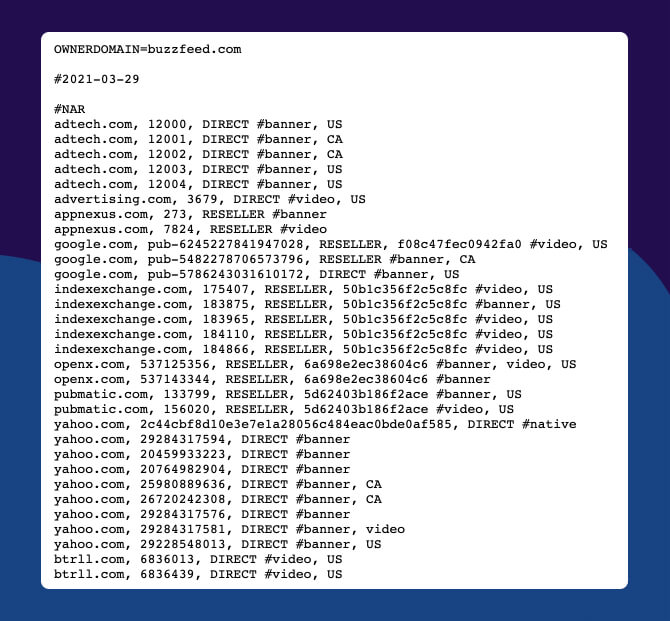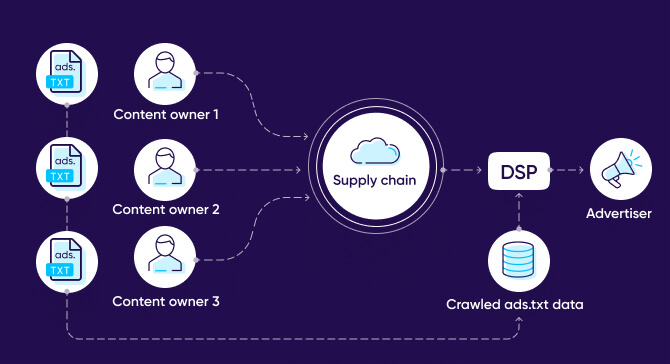
Ads.txt

Ads.txt is a text file publishers can add to their websites to list supply-side platforms (SSPs) and ad exchanges authorized to sell their ad inventory. It’s designed to increase transparency in programmatic advertising and prevent ad fraud.
What is ads.txt?
The “ads” in ads.txt stands for Authorized Digital Sellers. This is an initiative developed by the Interactive Advertising Bureau (IAB) to counter ad fraud, such as domain theft, alleged domain hijacking, and illegitimate inventory arbitrage.
Ads.text is a text file that publishers host on their web servers, listing companies authorized to sell their ad inventory. Advertisers and media buyers can use this information to validate sellers in a bid request, ensuring they don’t spend their ad budget on counterfeit ad inventory and unauthorized reselling.
Where is ads.txt located?
The ads.txt file is located in the root directory of a publisher’s website (websitename.com/ads.txt.) You can see a publisher’s ads.txt file by entering the URL into a browser. You can also check if a seller has a valid ads.txt file by looking it up on Google Ad Manager.
Is ads.txt mandatory?
No, ads.txt isn’t mandatory. However, it’s gaining popularity with publishers as it gives them more control over who can sell ads on their sites, preventing counterfeit inventory from entering the market.
As more advertisers use this feature to validate a publisher’s reliability while protecting themselves from spoofing attempts or fraudulent inventory, we can expect more publishers to implement ads.txt on their sites to build trust and drive ad sales.
Why does ads.txt matter?
Digital ad fraud cost advertisers worldwide $65 billion in 2021. Ads.txt helps verify sellers so brands can avoid spending their budget on counterfeit inventory, ensuring more money goes to legitimate publishers.
Digital advertising is an opaque industry, and ads.txt makes it more transparent. It helps prevent unauthorized reselling in programmatic advertising by allowing buyers to verify which supply-side platforms (SSP) are authorized to sell a publisher’s inventory, down to the exact web spot.
Advertisers and media buyers can also tune the algorithms of their demand-side platforms (DSP) to automate the process of screening dealers based on information in ads.txt files. This helps them minimize the risks of doing business with unauthorized resellers.
Meanwhile, brands can protect their reputation by ensuring their ads only appear on trustworthy websites.
What types of ad fraud does ads.txt help prevent?

Ads.txt primarily prevents domain spoofing, where a request comes from one site, but the ad is placed on another website of lower quality. With ads.txt, advertisers can see which SSPs are eligible to sell what inventory, so they don’t waste money on fake impressions. The technology helps bring inventory reporting to a higher standard.
Ads.txt can also deter inventory arbitrage, where a third party buys impressions, then repackages and resells them at a higher price. Even though technically not ad fraud, inventory arbitrage is a shady practice that diminishes trust across the industry. Ads.txt discourages this practice by listing authorized resellers of a publisher’s inventory, so publishers can protect their reputation in the open market.
Both domain spoofing and inventory arbitrage trick data-driven platforms used in programmatic advertising (like ad exchanges) into believing that the users are accessing high-quality inventory, whereas, in fact, the ads appear on a dubious website or are viewed through a covert application designed to generate fake impressions.
The benefits of using ads.txt
Aside from the benefits we’ve already covered in terms of cutting fraud, improving transparency, and building trust, you’ll be pleased to know that ads.text is pretty easy to use.
Publishers don’t need much technical expertise to implement an ads.txt file: you can create and upload one in just a few minutes. The readily accessible format is also easy to maintain — you can add or remove sellers at any time to keep the information up to date.
The process is safe and secure since only the website owner can upload and update the file. As a publisher, you can maintain control over your partnerships while preventing unauthorized reselling and protecting your reputation.
Considerations when using ads.txt
Ads.txt doesn’t solve all ad fraud, so publishers must still implement other best practices, such as using a quality ad platform and vetting its networks. You’ll also need to invest time and resources to keep your ads.txt files current.
Since it’s a manual process, human errors can impact the information’s accuracy and the initiative’s effectiveness. Moreover, scammers can use the 404bot to prey on unaudited ads.txt files, so it’s critical to maintain a tight and clean document.
How does ads.txt work?
Ads.txt serves as a public record of authorized digital ad sellers within the programmatic ecosystem.
A publisher adds the ads.txt file onto its website to confirm that it owns the domain and verifies partner accounts, such as ad exchanges and SSPs, that are eligible to sell its ad inventory. Programmatic platforms can also integrate ads.txt files to confirm which publishers’ inventory they’re authorized to sell.
The IAB Tech Lab recently released a crawler that can pull ads.txt files efficiently from publisher websites, allowing media buyers and advertisers to validate a large amount of inventory information quickly, compile a list of authorized sellers, and streamline the verification process.
When an advertiser receives a bid request from the publisher’s site, it can check the publisher’s account ID against the ads.txt file to ensure that the publisher and the inventory are legitimate. If the advertiser can’t validate the publisher’s account, it may choose not to bid on the inventory to safeguard its budget.
Ads.txt example: key elements and how to read it
To check the ads.txt file on any publisher site, type in the root domain followed by /ads.txt (in other words, domainname.com/ads.txt.) Below is part of the ads.txt file on the HuffPost website, available to the public at huffpost.com/ads.txt:

Each line in the file consists of three or four parameters separated by a comma.
Here’s what the fields stand for:
- Field #1 (required): The domain name of the SSP, video ad network, or ad exchange authorized to sell or resell the publisher’s ad inventory.
- Field #2 (required): This identifier corresponds to the domain name listed in field #1. It’s unique for every publisher on each SSP or ad exchange.
- Field #3 (required): This field indicates whether the inventory is sold via direct programmatic deals (DIRECT) or through an authorized partner, such as SSP or exchange (RESELLER.)
- Field #4 (optional): Only SSPs or exchanges registered with the Trustworthy Accountability Group (TAG) will have this Certification Authority ID.
- #[Display] (optional): The text behind the # sign is a comment from the publisher, often used to identify the type of inventory the vendor sells. It holds no value for advertisers, and the IAB crawler doesn’t pick it up.
Ads.txt 1.1: what you need to know about the latest update
The IAB Tech Lab introduced the industry-wide update in mid-2022. The new version clarifies the supply-chain relationships among publishers, demand-side partners, and intermediaries.
The primary changes are two new values added to the top of the file: OWNERDOMAIN (domain name of the company that owns the inventory) and MANAGERDOMAIN (domain name of the company that manages the ad inventory on behalf of the owner). This information helps improve supply-chain transparency and trust in the digital advertising industry.
IAB recommends that publishers include the OWNERDOMAIN data even if the website domain and owner domain are the same, especially for those who are both owners and sellers. The information can help buyers distinguish owned inventory from resold inventory. Publishers should also validate that all DIRECT entries are references to sellers’ accounts they can control directly.
How to create and implement ads.txt

If you use Google AdSense or Google Ad Manager, the service will generate an ads.txt file automatically. However, if you want to implement it independently, you can create a file manually.
How to create an ads.txt file
You can use any text editor (MS Word or notepad, for example) to write an ads.txt file and structure the information like the example above:
[ Ad exchange ], [ Publisher/account ID ], [ Relationship type ], [ TAG ]
Keep each SSP or ad exchange on a separate line and use a comma to separate each element.
How to validate your ads.txt file
Even a minor syntax error can cause an ad.txt file to break, so it’s critical to check the file before uploading it to your website. You can use various free online ads.txt validators, such as this one and this one, to automate the process.
How to implement ads.txt on a WordPress site
WordPress.org is the most popular content management system (CMS), and it’s also easy to add an ads.txt file using a plugin like Ads.txt Manager. After downloading and installing the plugin, navigate to the Settings section and click on ads.txt to open the window where you can input the data. Copy and paste the information from your ads.txt file to the text box and save the changes — you’re all set!
How to implement ads.txt on other CMS sites
If you’re using a CMS other than WordPress, such as Squarespace, Joomla, Hubspot, Drupal, or Wix, you can also add an ads.txt file to your site as follows:
- Ads.txt for Squarespace: Upload the ads.txt file to your site (instead of creating a new page) and then set up a redirect to point yourdomain.com/ads.txt/ to that file.
- Ads.txt for Joomla: Like WordPress, you can download a plugin and upload an ads.txt file via the interface.
- Ads.txt for Hubspot: Upload the ads.txt file to the CMS Hub and copy the file’s URL. Then, set up a redirect so yourdomain.com/ads.txt/ points to the file.
- Ads.txt for Drupal: Download the Drupal module for adding ads.txt, enable it on your dashboard, and upload the ads.txt file to the configuration page.
- Ads.txt for Wix: Go to Marketing Integrations on your dashboard and click Connect under Ads.txt. Click Add ads.txt file, paste the text from your ads.txt file into the text box, and hit Save.
How to implement ads.txt with Google AdSense
You can add an ads.txt file to your website through Google AdSense. Log into your account, navigate to Sites, and click the down arrow to open the Create an ads.txt file for… message. Download the file to your computer and upload it to your site’s root directory.
If you don’t see the Create an ads.txt file for… message, you’ll need to enter your publisher ID in the ads.txt file manually. You can find it in Account > Settings > Account Information. If you use other ad networks besides Google AdSense, contact them for their ads.txt information and add it to your ads.txt file before uploading it to your website.
How to implement ads.txt with Google Ad Manager
Publishers can use Google Ad Manager to generate and add an ads.txt file. Sign into your account, then go to Admin > Ads.txt Management > Web ads.txt to create an ads.txt file for a website or an app-ads.txt file for an app. The platform will generate the file automatically, and you can copy the content or download the file. Then, upload the file to your root domain. Wait at least 24 hours and verify that the crawlers can access the ads.txt file in the Ads.txt Management section.
Key takeaways
- The IAB Tech Lab developed ads.txt to combat ad fraud, primarily domain spoofing and counterfeit inventory. It also helps increase trust and transparency in programmatic advertising.
- The ads.txt file lists ad networks and SSPs authorized to sell a publisher’s ad inventory. Advertisers and media buyers can use the information to verify a bid before accepting it.
- Ads.txt helps advertisers avoid revenue loss due to unauthorized reselling, and allows publishers to protect their reputations in the open market.
- The Ads.txt 1.1 update included two new values — OWNERDOMAIN and MANAGERDOMAIN — to help improve supply chain transparency.
- Creating an ads.text file for your site is easy: you can compile the list manually or generate the file using Google AdSense or Google Ad Manager. It’s important to ensure that each record is in the correct format when creating an ads.txt file, and to keep the file accurate and up to date. .



